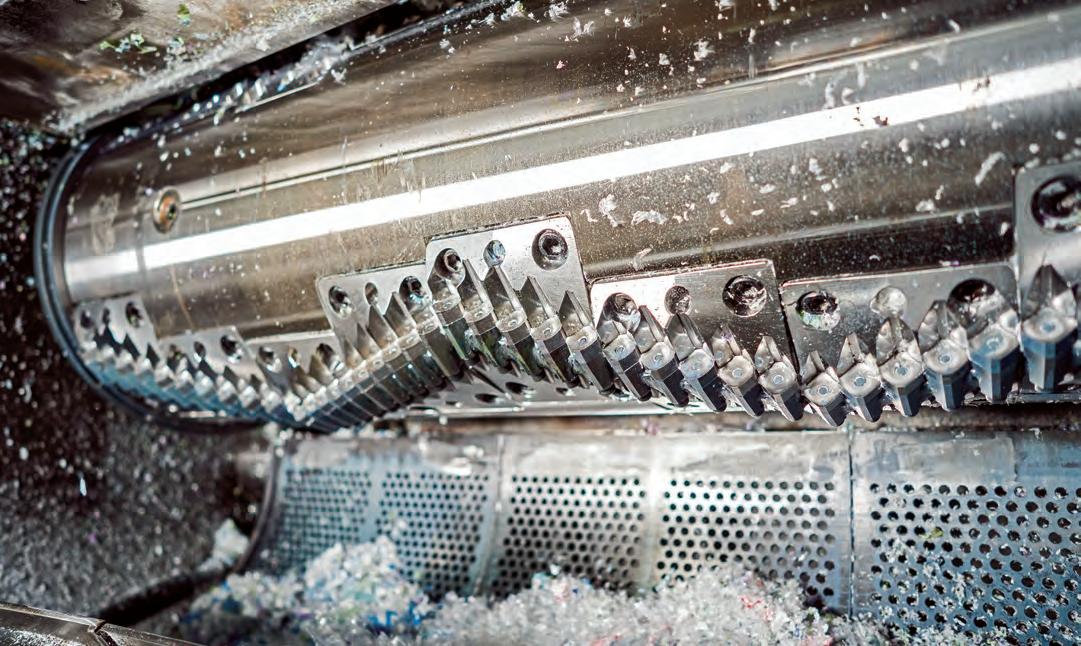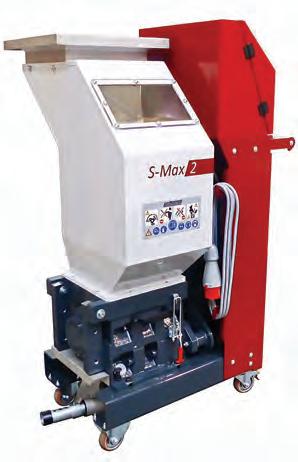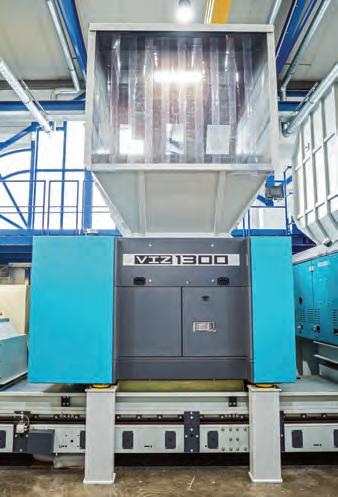
9 minute read
SIZE REDUCTION: On the cutting edge
No plastics processor actually wants to generate waste, but they all do. Efficiently reducing bad parts and other plastic waste into quality regrind for reuse is what separates the pros from the pretenders. These latest size reduction technologies can help. By Mark Stephen, editor Y ou can go a long way doing imitations. Jim Carrey got his start that way, and Rich Little made it his whole career. In a weird way, the makers of size reduction equipment for plastics can probably relate. When you get right down to it, the overall goal of most plastic recycling programs is to turn scrap and non-conforming parts into material that imitates virgin resin by being a similar size and form, and with the proper material characteristics to be blended with original resin.
But if size reduction involves going small, it’s not a small thing: Day in and day out, hundreds of plastics processors use size reduction equipment alongside injection molding, blow molding, extrusion, and thermoforming machines. They’re also used for general recycling purposes.
So when new technologies come out – either in granulators, which handle runners and small to medium-sized parts; or shredders, for large or very dense parts – virtually everyone has an interest in knowing.
So here’s a look at some of the latest offerings. SLOW IT DOWN Slow-speed granulation technology has been around for two decades, and 25 rpm has always been the worldwide standard for slow-speed operation. But that may change with Rapid Granulator’s new OneCut Pro granulator, a beside-the-press unit that allows injection molders to adjust the rpm range when granulating at a slow speed from the standard 25 rpm to a bandwidth of 15 to 35 rpm (plus/minus 40 per cent rotor speed), for optimal quality regrind. Running at 15 rpm, the OneCut Pro improves the quality of ground brittle materials and minimizes dust and – very importantly – noise. Speed can easily be increased to 35 rpm – increasing the capacity of the granulator by 30 to 40 per cent – to accommodate larger amounts of material. “The OneCut Pro comes equipped with EnergySmart, a new system that lets the operator stop the machine as material is fed into it for an energy consumption reduction of up to 80 per cent,” said Bengt Rimark, Rapid’s CEO. “It also uses our Stop & Go technology, which lets the machine granulate in intervals to further save energy, with zero energy consumption and no noise during the pause mode.” Another offering in the low-speed category is from Wittmann Group. Replacing its former Junior and Minor models, the company’s new S-Max screenless granulator models – the S-Max 2, S-Max 2 Plus, and S-Max 3 – are low-speed granulators designed for the inline recycling of sprues made of hard and brittle engineering resins, and generate material throughputs of 27, 44, and 66 lbs per hour, respectively. Mounted on casters for mobility, the three granulator models have ON THE CUTTING EDGE Wittmann’s S-Max screenless granulator models are low-speed granulators designed for the inline recycling of sprues.

an interface that enables full communication with the injection molding machine and, as an option, a shutdown function is available. When the injection molding machine is “off,” the granulator stops automatically, helping to save energy. They also have ARS auto-reversing control, which clears jams by automatically stopping and reversing the rotor. In a nutshell, Wittmann said, the granulators produce less noise, save more energy, have a more compact footprint, need less maintenance, are equipped with hardened cutting tools, provide for easy cleaning, and also have excellent safety features. RECYCLERS REJOICE Granulator maker Rotogran International Inc. moved from its original headquarters in Vaughan, Ont. into a much larger manufacturing plant in the nearby town of Bolton in the fall of 2018 – a relocation made necessary in large part by growing its business as it gets more involved in recycling. “We’re definitely moving into recycling as that industry expands,” said Rotogran president Mike Cyr. Which, ironically, also benefits its plastics processing customers. “Production is the name of the game in recycling – recyclers want heavy-duty granulators that can run at maximum capacity around the clock,” Cyr said. “Processors don’t usually run granulators at full capacity, but when they do – if they’re shock-loading to get rid of a big collection of bad parts – they reap the benefits from this heavy-duty construction as well.” For both recyclers and processors, Cyr said, Rotogran has been equipping its granulators with more and more innovative components of late. One example is wear-resistant plates that can be changed rapidly – in less than half the time it takes to change blades, Cyr said. “The plates are optional on our granulators,” he said. “Wear-resistant plates aren’t new per se, but we’ve improved ours by making them from the same tool steel as the rotor blades are made from.” Rotogran can also put a pathway deflector in the cutting chamber itself, deflecting the material back directly into the cutting circle after the first cut. “The removable, replaceable deflector is an optional upgrade that greatly improves throughput,” Cyr said.
Another size reduction machinery specialist zeroing in on the recycling market is Piovan. The company’s newest cutting innovation is the U&G disposable knives system, which promises longer knife life for recyclers – as well as processors – thanks to the application of CPM10V tool steel. “U&G disposable knives are a clamped knife design allowing for a significantly smaller knife to be used,” the company said. ”After a conventional knife is sharpened to its minimal level, 95 per cent of the knife is rendered useless and scrapped. Since the U&G disposable knives are so much smaller, a more exotic, more expensive tool steel can be used for longer life and still cost less than conventional knives utilizing expensive D2 tool steel.” And for recyclers – for whom, even more than processors, downtime equals money lost – these disposable knives mean less time wasted for knife changes. “U&G knives take about half as much time to change as conventional knives,” Piovan said. “The difference is even greater with older technology granulators with fixed knives and no knife gap pre-adjustment fixture – it’s the difference between changing a 300 gram knife instead of a 15 kg knife.”
Also built for plastics recycling, Vecoplan LLC’s new VIZ series – which stands for Vecoplan Infinity Shredders – are designed so that, depending on the requirements, the user can choose between the HiTorc drive with its powerful start-up phase and high torque; or the ESC, Vecoplan’s frequency controlled, belt-driven direct drive. “Vecoplan also came up with a new rotor design that features bolted tool holder plates with variable cutting tip sizes, making rotor changes unnecessary,” said Greg Parent, the company’s Canadian sales representative. “Users only have to exchange the plates to quickly adapt the cutting geometry to different output grain sizes – the rotor remains in the machine.” Compared to earlier shredders, the VIZ also has an improved ram height to handle entire bales. The working chamber of the machine was also enlarged, permitting reliable shredding of bales with models 1300 and higher. “In a comparable Vecoplan model range this is possible only with sizes 1700 and higher, although the smaller version would have the necessary throughput,” Parent said. “Users can also equip the machine with a second counter knife.” NEW AND IMPROVED Other size reduction machines are just plain new and/or improved. The WLK 1500 shredder from Weima features new safety features for universal operation. The modified Weima WAP gearbox has a safety clutch located in the sensor monitored belt pulley, protecting the shredder from impurities and major damage. And it makes automatic stopping possible at any time. For operations that shred thin film or fibres, meanwhile, clogging is prevented by the segmented floor guide and the precise guidance of the ram that presses the material to be shredded against the rotating rotor. The standard hydraulically lowered swivel screen basket is designed to improve accessibility and simplify maintenance. Additionally, all WLK shredders have a Pipespacer hopper that prevents material bridging, which is important when shredding objects such as large purgings. The WLK series shredders can be fitted with either the universal Vecoplan’s VIZ shredder can be equipped with either with a high-torque, quick-start drive or a frequency controlled, belt-type direct drive.

V-rotor or the F-rotor developed especially for film and fibres. In 2018, Conair Group launched its portfolio of Viper granulators, consisting of 14 different models with standard features that include improved sound insulation, hardened and water-cooled cutting chambers on most models, as well as bigger screens for increased throughput. From small pressside units to large, central granulators, the Viper product line includes models with rotor diameters of 6, 8, 12, 17, and 23 inches, or 140, 200, 300, 420, and 570 mm; and maximum throughputs from 80 to 3,800 lbs per hour, or 36 to 1,724 kg per hour. Tangential-feed cutting chambers are standard on smaller grinders, while large units come in a super-tangential configuration to facilitate feeding of large and bulky scrap. Eighteen months later, Conair is still surfing the Viper wave, but – to keep the metaphor going – carving when required. “We’re customizing various Viper models to suit the specific needs of individual customers,” said Dave Miller, Conair’s general manager, size reduction. “Processors want to be able to tie the granulator controls into other plant systems as part of a smart factory approach. And our customers in the packaging and film sectors want to be able to monitor as much as of the granulator as possible – amperage, cutting chamber temperature, vibrations, how long it’s been running, and more – because, for them, a granulator is a key production compo

nent, and if it goes down there’s a tremendous amount of scrap that gets generated that can shut down the line. We can accommodate all of these requests.”
The end goal may be to imitate virgin resin, but there’s nothing phoney about any of these size reduction technologies. CPL
RESOURCE LIST Conair Group (Cranberry Township, Pa.); www.conairgroup.com; 724-584-5500 Dier International Plastics Inc. (Unionville, Ont.); www.dierinternational.com; 416-219-0509 Industries Laferriere (Mascouche, Que.); www.industrieslaferriere.ca; 450-477-8880 Turner Group Inc. (Seattle, Wash.); www.turnergroup.net; 206-769-3707 Piovan Canada (Mississauga, Ont.); www.piovan.com; 905-629-8822 Rapid Granulator Inc. (Leetsdale, Pa.); www.rapidgranulator.com; 724-584-5220 DCube (Montreal); www.dcube.ca; 514-272-0500 JL Plastics Machinery Inc. (Thornhill, Ont.); www.jlplastics.ca; 647-554 3679 Equipment Resources NW (Ridgefield, Wash.); www.ernw.com; 360-892-6005 Rotogran International Inc. (Toronto); www.rotogran.com; 905-738-0101 Vecoplan LLC (Archdale, N.C.); www.vecoplanllc.com; 336-447-3573 Greg Parent; 416-678-0154 Weima America Inc. (Fort Mill, S.C.); www.weimaamerica.com; 888-440-7170 Wittmann Battenfeld Canada Inc. (Richmond Hill, Ont.); www.wittmann-group.com; 905-887-5355
SEE AND FEEL THE DIFFERENCE






